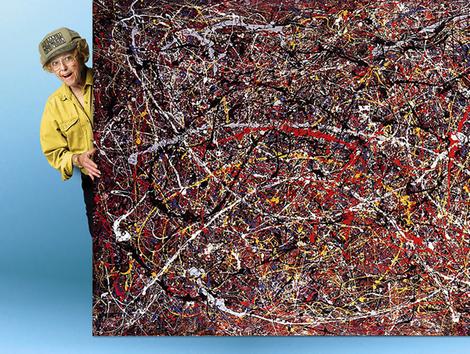« 88 Minutes (2007) – Movie Review | Home | Indoctrinate U (2007) – Movie Review »
Who the #$&% Is Jackson Pollock? (2006) – Movie Review
By Robert L. Jones | June 12, 2008

Grandma Teri Horton buys an authentic Jackson Pollock for $5 at a garage sale, but New York's elitist art snobs aren't about to let her buy her way into their rarefied environment
Show Me State of Mind
[xrr rating=4/5]
Who the #$&% Is Jackson Pollock? Featuring Teri Horton, Tod Volpe, Ben Heller, Nick Carone, John Myatt, Peter Paul Biro, Thomas Hoving, Jeffrey Bergen, Joe Beam, Judy Hill, Teri Paquin, Bill Page, Ron Spencer, and Allan Stone. Original music by Terence Blanchard, with additional music by Derrick Hodge. Cinematography by William Cassara. Edited by Jay Freund. Written and directed by Harry Moses. (Picturehouse/Hewitt Group, 2006, Color, 74 minutes. MPAA Rating: PG-13.)
Teri Horton—a 73-year-old grandma and retired over-the-road truck driver with only an eighth-grade education—just won’t (in the words of Tom Petty’s immortal ditty) back down. She’s a tough old broad on a mission, and she won’t let anyone or anything get in her way. I would say this plainspoken dame is just about the best-written heroine I’ve seen onscreen in a long time, save for one thing: She’s not “written” at all, but the real-life subject of this first-rate documentary directed by Emmy- and Peabody-award-winning “60 Minutes” producer Harry Moses.
This delightful movie has its origins on a fateful day about fifteen years ago, when Horton purchased a huge painting for five bucks at Dot’s Spot Thrift Shop in her hometown of San Bernardino, California. She intended it as a gift to cheer up a friend, Teri Paquin. But the painting, an oversized canvas with a mass of colorful swirls and squiggles, didn’t exactly impress Paquin. Both gals thought it downright ugly and wanted to practice throwing darts at it. When they were unable to get it through the door of Paquin’s mobile home, Horton threw it back into the bed of her pickup truck and later tried hawking it at a yard sale.
When one of her customers, a local art teacher, informed her that she just might be the owner of an original Jackson Pollock—and that it was potentially worth millions—
Horton’s response was, “Who the f— is Jackson Pollock?” (Hence the title.)
Teri Horton soon finds out plenty about the seminal twentieth-century abstract artist who worked in the “stream of consciousness.” She also finds out that her painting is potentially worth $50 million. But when she starts to approach art dealers, none will take her or her painting seriously.
You see, the painting lacks provenance. In the high-stakes world of art investment, provenance is a paper trail that authenticates a work’s origins as well as its chain of ownership. By this point, years have passed, and Dot and her thrift shop are long gone. And, unlike a 1967 Belvedere GTX, paintings don’t come with VIN numbers.
After the International Foundation for Art Research declares, in an unsigned document, that the painting is “not by the hand of Jackson Pollock,” Teri’s son—auto mechanic and businessman Bill Page—puts her in touch with someone whose expertise might turn her fortunes around.
Peter Paul Biro is a leading forensics art authenticator from Montréal, with many years experience restoring art masterpieces. The soft-spoken but self-assured Biro is the movie’s cerebral hero, working the case much as a police detective would. “I look at a painting almost like a crime scene,” he says. “But not who committed a murder. I’m looking for who committed the art.” In the course of his investigation, he compiles an impressive amount of forensic evidence, exactly matching a fingerprint from the painting to two established Pollocks, one in a private Berlin collection, the other from London’s Tate Gallery. He also matches the same print to a paint can in Pollock’s Long Island barn, which was also his studio and is now preserved as a museum. Further, Biro finds paint splatters from the barn’s floor that, when examined spectrographically, exactly match those found on Teri’s canvas.
In a sane world, with Biro’s credible findings, authenticating the painting as a genuine Pollock ought to have been a done deal. Ah, but no. New York art dealer Jeffrey Bergen summarizes the extreme reluctance of art connoisseurs to give Biro’s findings credence: “The art world and the justice system, they’re kind of two different worlds.”
Indeed. As much as this documentary is a study of the nature of art, it’s also a dissection of the subjectivism, evasion, intellectual pretension, and epistemological obfuscation that typifies the art world’s highest echelons.
For example, contradicting Biro’s scholarship and evidence, expert Pollock collector Ben Heller remains dubious of the painting’s authenticity. “That . . . layering of one color on top of another . . . makes me uncomfortable. This stuff, it just doesn’t, this doesn’t look like a Pollock. Doesn’t feel like a Pollock, doesn’t sing like a Pollock.”
Thomas Hoving, former director of the Metropolitan Museum of Art, is the film’s chief villain. If an actor were to deliver such an arrogant performance as a pompous ass of a curator, he’d be mocked as an over-the-top ham. It’s hard to believe that this is no performance, but an actual interview with a real person.
“My instant impression, which I always write down—you know, the ‘blink,’ the one-hundredth of a second impression—was ‘neat-dash-compacted,’ which is not good,” Hoving pontificates. “It’s pretty, it’s superficial and frivolous. And I don’t believe it’s a Jackson Pollock. It has no appeal. It’s dead on arrival.”
When director Moses counters that Horton would respectfully disagree, Hoving gesticulates nervously, revealing transparently thin skin and patrician annoyance that such a specimen of the hoi polloi—whose home is in a trailer park and whose idea of art is Norman Rockwell—would dare question his authority. “She has no right to be bitter, because what she has is no good, so why should she care?” Hoving sniffs (not figuratively, but literally sniffing). “Yeah, but she knows nothing, so why does it matter to me? I’m an expert. She’s not.” Hands fluttering, Hoving dismisses investigator Biro’s evidence out of hand: “So fingerprints, all this stuff, is kind of that lovely ‘what if.’ But, it’s not essential to the heart of the artistic soul of that thing.”
After the interview, Biro poses a rhetorical question: “If this gentleman, in some rage, butchered his wife, and was taken to court, and the bloody knife was produced as evidence and put in front of the judge, what would [he] say? ‘I don’t recognize the fingerprint?’ He’d be booted out of court!”
Even if Biro and Teri were able to get past Hoving’s antagonistic snubbing, they still have a gauntlet to run. Facts pale in comparison to the “learned” opinions of art investors. As Bergman explains, “There has to be consensus behind the painting by quote-unquote ‘experts,’ or else you could end up in a pile of…problem.”
“Consensus” as the authoritative basis for scientific evidence? Hmm, where have we heard that before?
Teri enlists the aid of Tod Volpe, a smooth shark of an art dealer who’s served time in federal prison for embezzling clients’ money. When asked whether that bothered her, she replied, “That didn’t bother me, the fact that he went to prison for fraud, because by this time I know the whole art world is a bumble-frapping fraud.”
In a TV interview this past May, Teri expanded on this corruption. “There is no way anybody can get up and look at that painting, or any Pollock for that matter, and be able, by visual examination and wait for this mystical feeling that they get that comes over them, to decide whether it is, or whether it is not authentic.” The native Missourian added: “They call it ‘connoisseurship.’ [I call it] bulls—.”
This is a thoroughly enjoyable, even entertaining, documentary. Harry Moses avoids the outright manipulations of a Michael Moore, instead skillfully juxtaposing Paul Biro’s exacting scientific methodology with lengthy interviews of the haughty elites who run New York’s art scene. Even unedited, they hang themselves with their own words.
Viewers find out more about who the hell Teri Horton is than they do about Jackson Pollock (despite the director’s tenuous, somewhat unsuccessful attempt to draw parallels between the volatile characters of the two). What I admire most about Teri is her utter refusal to be patronized. She remains adamant about selling her painting not one penny below market value. Despite having the collective doors of the art establishment slammed in her face, she has received an anonymous offer for $2 million and another from a Saudi Arabian collector for $9 million. She has refused both. “It was principle that I would not sell it for two million dollars,” she said.
The day may or may not come when Teri Horton can sell the painting she bought for five bucks for what it’s worth in the marketplace, but one thing’s for certain about this plucky woman: Her soul is not for sale.
Robert L. Jones is a photojournalist living and working in Minnesota. His work has appeared in Black & White Magazine, Entrepreneur, Hoy! New York, the New York Post, RCA Victor (Japan), Scene in San Antonio, Spirit Magazine (Canada), Top Producer, and the Trenton Times. Mr. Jones is a past entertainment editor of The New Individualist.
Topics: Documentaries, Independent Films, Movie Reviews | Comments Off on Who the #$&% Is Jackson Pollock? (2006) – Movie Review
